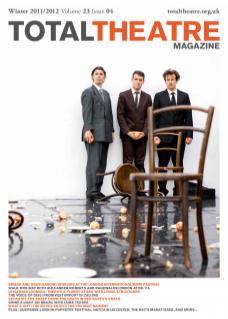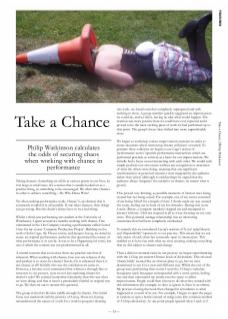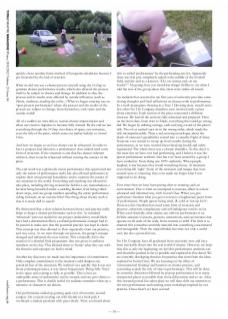Taking chances. Something we all do at various points in our lives, be it in large or small ways. It’s a notion that is usually looked on as a positive thing, as something to be encouraged. We often take chances in order to achieve something – He Who Dares Wins!
Yet when making performance work, ‘chance’ is an element that is commonly avoided if at all possible. If one takes chances, then things can go wrong. But this doesn’t always have to be a bad thing.
Whilst a third-year performing arts student at the University of Winchester, I spent around six months working with chance. This culminated in No I In Company creating a performance called Secured Chaos for my course ‘Company Production Project’. Building on the work of John Cage, the Fluxus artists, and Jacques Lecoq, we aimed to create an original performance aesthetic that questioned the nature of what performance is or can be. It was to be a Happening (of sorts), but one in which the content was not predetermined at all.
A central concern that soon arose from our practice was that of rehearsal. When working with chance, how can one rehearse if the end-product is to occur by chance? Surely, if it is rehearsed then it is not chance at all? Initially this was the conclusion we came to. However, a lecturer soon commented that without a through-line or structure to our process, were we not just exploring chance for chance’s sake? We realised (somewhat reluctantly) that this was what we were doing, and that it wasn’t a particularly fruitful or original way to go. We then set out to answer this question.
The group arrived at this idea (oddly enough) by chance. Our initial focus was maskwork and the practice of Lecoq. However, having misunderstood the nature of a task for a work-in-progress showing one week, we found ourselves completely unprepared and with nothing to show. A group member quickly suggested an improvisation we could do, and we did it, having no idea what would happen. The reaction was more positive than we could have ever expected and it proved to be the most exciting piece of work we had performed up to that point. The group’s focus then shifted into more unpredictable areas.
We began to workshop various improvisation exercises in order to create situations where interesting ‘chance collisions’ occurred. To generate these collisions we began to use Cage’s notion of ‘performance scores’ (specific performance instructions which are performed precisely as written) as a basis for our improvisations. We initially had a focus on not interacting with each other. We would each simply perform our own scores without any recognition or awareness of what the others were doing, meaning that any significant synchronicities or perceived narrative were imagined by the audience rather than ‘given’ (although it could perhaps be argued that the audience always ‘imagines’ the narrative in theatre, no matter what is given!).
This proved very limiting, as possible moments of interest were being created but not being seized. For example, one of my scores consisted of me being ‘blind’ for a length of time. I slowly made my way around the room, feeling out in front of me for obstacles. During this score Louise (Byrne, a company member) stopped me and attempted to interact with me. I did not respond at all as I was focusing on my own score. This potential onstage relationship was an interesting occurrence that had been completely overlooked.
To remedy this we introduced Lecoq’s notions of ‘le jeu’ (playfulness) and ‘disponsibilité’ (openness) to our practice. This meant that we not only aware of each other but constantly open to interactions. This enabled us to have fun with what we were creating, making everything that we did subject to chance and change.
Then a decisive moment came in our process: we began experimenting with the I-Ching (an ancient Chinese book of divination). This oft-used ‘chance bible’ seemed like an obvious place to go, but we were determined to use it in a new and different way. Whilst the rest of the group were performing their scores I used the I-Ching to calculate hexagrams (each hexagram corresponded with a word, action, feeling etc) and then announced my results into the space to affect improvisation. People could then choose to do what they wanted with this information (for example, to obey it, ignore it, force it on others). My process of using the book then changed in accordance to what happened as a result of its use. For example, I began to open the pages at random or spin a bottle instead of using coins (the common method of I-Ching calculation). At one point people ignored what I said, so I quickly chose another faster method of hexagram calculation because I got frustrated by the lack of reaction.
What we did was use a chance process (myself using the I-Ching) to generate chance performance results, which also allowed the process itself to be subject to chance and change. In addition to this, the process and its results were affected by outside influences (such as illness, tiredness, needing the toilet...) What we began creating was an ‘open process performance’ where the process and the results of the process are subject to change, from themselves, each other and the outside world!
All of a sudden we were able to sustain chance improvisation and allow our creative impulses to become fully formed. By the end we ran everything through the I-Ching: our choice of space, our costumes, even the title of the piece, which came out (rather luckily) as Secured Chaos.
And here we began to see how chance can be rehearsed. In order to have a purpose and direction, a performance does indeed need some form of structure. If the structure is one that has chance inherent within it, then it can be rehearsed without ruining the essence of the piece.
The end result was a gloriously messy performance that questioned not only the nature of performance itself, but also allowed performers to explore their own personal boundaries and to examine the nature of our existence in the world. Everything and anything was allowed to take place, including driving around the field in a car, masturbation, a lecturer being breastfed under a suckling blanket, fruit being rolled down steps, and one group member spending the entire performance riding furiously on an exercise bike! One thing about chance work is that it is rarely dull to watch!
We discovered that a close relation between theory and practice really helps to shape a chance performance such as this. As standard ‘rehearsals’ were not needed in our project (indeed they would likely have had a detrimental effect) a refined performance concept had to be present to make sure that the potential practice was kept in check. This concept was then allowed to flow organically from our practice, and vice-versa. As we went through our process, the group’s concept changed and informed the next session. This eventually led to the creation of a detailed final programme that was given to audience members on the day. This allowed them to ‘frame’ what they saw with the theories and concepts we had in mind.
Another key discovery we made was the importance of commitment. Only complete commitment to the moment could dampen any potential fear of the uncertain. We realised very quickly that it was not about performing presence, it was about being present. Being fully ‘there’ in the space and existing as fully as possible. This is how an undeniable sense of authenticity can be created, and can give clarity to a performance. This is doubly useful for audience members when say a narrative or characters are absent.
Our performance ended up gaining quite a lot of notoriety around campus. On a recent evening out with friends in a local pub, I overheard a student proclaim with great shock: ‘Have you heard about this so-called ‘performance’ by the performing arts lot. Apparently there was this girl, completely naked in the middle of the football field, and she said to a lecturer, “Do you wanna suck on my boobs?”’ Ah gossip, how you transform things! Suffice to say when I told the rest of the group about this, there were smiles all round.
An incident that occurred in my first year of university provides some closing thoughts and final reflections on chance work in performance. In a work-in-progress showing in a Year 1 Devising class, myself and a few other No I In Company members were involved with a piece about emotions. Each section of the piece concerned a different emotion. We had all the sections fully rehearsed and prepared. Then on the show date, from start to finish, everything that could go wrong did. We began by walking onstage, each carrying a word of the piece’s title. Two of us carried ours on in the wrong order, which made the title incomprehensible. Then a sad, moving monologue about the death of someone’s grandfather turned into a comedic flight of fancy. Someone even started to sweep up food crumbs during the performance, as we were worried about breaking health and safety regulations! The whole show was a chaotic shambles. To this day it is the most fun we have ever had performing, and I believe it was the purest performance aesthetic that has ever been created by a group I have worked in. Everything was 100% authentic. When people laughed, it was because they found something funny. At moments everything felt ‘right’. Some of the moments and images that were created were so stunning, they even made me forget what I was supposed to be doing.
Ever since then we have been pining after re-creating such an environment. This is what we attempted to recreate, albeit in a more advanced and informed way, with Secured Chaos. When you give performers freedom what you get in return is a heightened, purer form of performance. People ignore being tired, ill, cold or ‘not up for it’. However, this freedom does need some form of structure and purpose, otherwise complacency and self-indulgence tend to set in. When used shrewdly, what chance can offer in performance is an infinite amount of actions, gestures, interactions, and occurrences that operate on all ends of the scale, from extreme to mild. The trick is to channel this somewhat unwieldy material into something concentrated and manageable. Then the unpredictable becomes not only a useful tool, but also a powerful one.
No I In Company have all graduated from university now and have been inevitably thrust into the real world of chance. However, we hope that this is only the beginning; we feel this performance aesthetic can and should be pushed as far as possible and explored in fine detail. We are currently developing theories for practice that stem from the ideas explored in Secured Chaos. We are focusing on the effect of ‘environmental framing’ and location on chance practice, and examining acutely the role of time in performance. This will be done by extensive discussion followed by pop-up performances in as many unexpected places as possible then revised discussion and so on. After this research period has taken place we will then shift our attention to the next performance and running some workshops inspired by our practice. Chaos hasn’t yet been secured.


